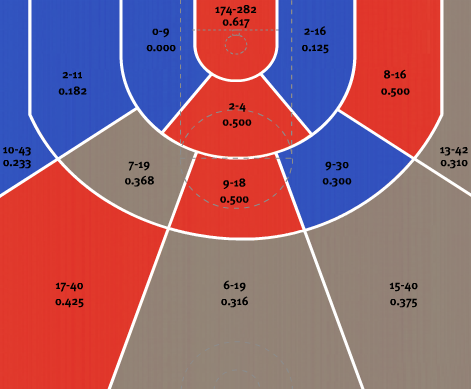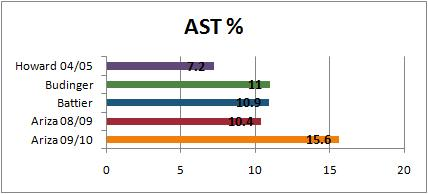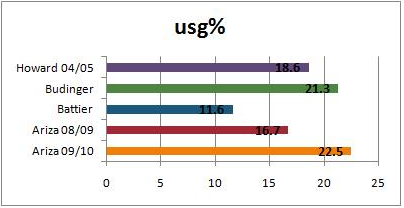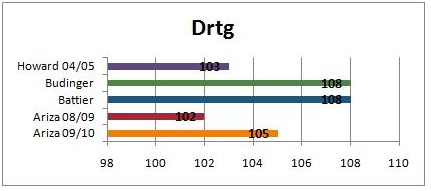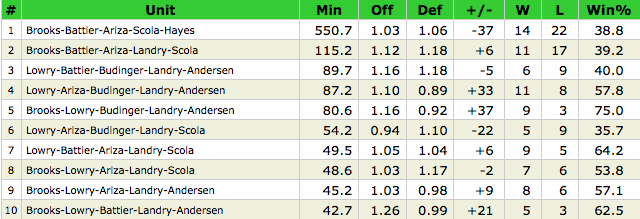At the time of this writing, the Houston Rockets are at the half-way mark of their 2009-2010 season. It would now be appropriate to revisit the observations and assertions I had made in November regarding Trevor Ariza.
Through Monday’s games, Ariza is now averaging 15.9ppg on 38% shooting (31% from 3), 5.6 rebounds per game, 3.7 assists per game, and 1.8 steals per game.
In Part 1, I had made three primary assertions:
- Trevor Ariza will never become a go-to option for a good team.
- Trevor Ariza is the perfect role player for this team.
- This signing was a slam dunk.
In addition to these primary assertions, I also want to revisit the other observations I had made in that November post.
I have compiled the statistics of Ariza thus far in 09/10, Ariza in 08/09, Shane Battier thus far in 09/10, Chase Budinger thus far in 09/10, and Josh Howard in 04/05. I included the latter four as comparative reference points.
Revisiting Ariza’s 08/09 with the Lakers allows us to identify the areas of production which were impacted by his new role this season.
Battier and Budinger serve as convenient barometers to gauge Ariza’s production as they essentially fulfill roles identical to his on the Rockets.
As for Howard, in Part 1, I had identified the Dallas forward as a career best-case-scenario for Ariza:
“Similar to a Josh Howard, if evolved, I envision Ariza using his adequate handles to dribble around screens to pull up over his defender for mid-range jump-shots. Such an addition to his arsenal is not only reasonable and realistic, but would vastly amplify his overall offensive potency.”
I chose Howard’s 04/05 campaign because it was in that year that he was in a situation similar to Ariza’s, being given a significant role in his team’s offense for the first time.
*
The italicized points under each sub-category are my observations from Part 1.
Offensive Repertoire
No mid-range game; No post-up game; Some pull-up ability
No mid-range Game
As we can see, Trevor is shooting 33% from mid-range. His accuracy is fairly decent from the left side, as he is 10-23 overall. However, the majority of his shots from mid-range have come from the right side of the court where he has gone 15-49 for 31%.
Let’s take a look at Howard in ’05.
Howard shot 43% from mid-range, but was deadly from the left side with a 50% accuracy rate.
Trevor’s shot chart from last year doesn’t help much other than to confirm that his favorite spot inside the arc seems to be at the right elbow.
No post-up game
While he attempts it a lot, Trevor is very ineffective in the post. He has a weak build and very poor footwork. While backing his man down is clearly out of the question, Trevor also has not shown any capability to shoot out of the post-up, whether it be with a jump hook, fadeaway, or turnaround.
Ariza has had some success with a move in which he receives the ball in the post, faces up, steams forward in one direction, comes to a halt, and then dips under with the opposite hand. I also do recall a few spin moves from the post which seemed somewhat promising.
Some pull-up ability
Trevor has shown hints of an ability to pull-up off the dribble in that he actually looks very comfortable and fluid in the motion. He can dribble to his left and rise up over his defender with McGrady-esque form. This observation was what had initially given me some hope for later development.
Unfortunately, while his form is impressive, there is very little accuracy. In addition, he has no ability whatsoever to shoot while going to his right. As I explained in Charting Kyle Lowry, it is the ability to shoot accurately while driving to the strong hand which I feel distinguishes the elite from the rest of the pack.
Overall, Ariza’s offensive repertoire is limited. He tries everything but has very little success.
Finishing
Poor finisher in heavy traffic; Poor body control in mid air; Gets stuck in mid air with nowhere to go
Trevor is a poor finisher in heavy traffic. From 82games, on close shots – shots defined as close to the basket, but not dunks – he is shooting only 42%. There is no data for Howard’s ’05, but this season, Josh is shooting 63% on close shots.
Trevor finishes poorly because he does not have the strength to absorb contact nor the ability to contort his body in mid air to avoid the shot-blocker.
Ariza’s saving grace is his athleticism. If given a clear path to the hoop against a rotating defense, he can swoop through for the flush. This is why Trevor thrives as a slasher. When put in situations where he doesn’t have to make decisions, Trevor can be very good.
Passing
Poor passer off the dribble
We can see that Trevor has by far the highest ast% of the group.
However:
The chart shows that other than the rookie Budinger, Trevor also has a much higher usg% than any of the other subjects.
Despite his 3.7 assists per game, Trevor is not a good passer. Much of this production is inflated by the system in which he plays. The Rockets’ is an offense predicated upon ball-movement and Trevor is one of the primary handlers. Naturally, as an NBA player, he is capable of making the routine pass to open teammates. However, Ariza has demonstrated no ability to create for others or even find them in scoring position if he himself is put in a tight spot. Even worse, Trevor is also an unwilling passer. It has become routine to see him get stuck in awkward positions and, rather than passing out to a teammate, fling an off-balanced, contested jumper.
Ball Handling
Struggles with cross-over dribble against tight pressure; Can dribble
sufficiently; Can drive in both directions and change directions when not facing tight pressure
We can see from the chart that Ariza has the highest tov% amongst those listed.
However, Trevor is an adequate ball-handler. He can bring the ball up situationally and also dribble with either hand in either direction against light pressure. This is what makes him dangerous as a slasher. If facing an off-balance defense, he has the capability to weave and change directions to get to the rim.
Trevor’s problems come when facing tight pressure. Unable to evade the defender, he routinely picks up his dribble. His poor footwork also compounds his problems as his feet often slide from under him when he comes to a stop.
Slashing role players need to use their speed and quickness to get to the rim against rotating defenses. Elite players can advance through evasion and are not dependent upon their defender’s positioning. Ariza simply has no ability to make counter moves against defensive pressure. This is precisely why it was so preposterous that some actually claimed/thought he was brought in as a go-to option for this team.
Shooting
Deadly shooter
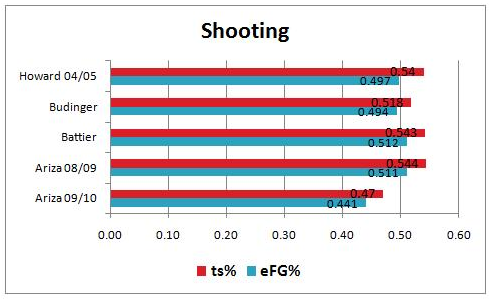
ts% is a measure of shooting efficiency that takes into account 2-point field goals, 3-point field goals, and free throws; eFG% is simply a statistic which adjusts for the fact that a 3-point field goal is worth more than a 2-point field goal
We can see that I was wrong when I described Ariza as a “deadly shooter.” Looking at the numbers, he has by far the lowest shooting accuracy out of any of the players.
However, it would be unfair to characterize Ariza as an intrinsically bad shooter. Ariza’s accuracy was much higher in 08/09 with the Lakers. This would obviously be because the majority of his shots were uncontested set-shots.
While I don’t have any hard data to support this claim, I think most would agree that in Houston, not only have his shots been contested, but a significant proportion of them have come on the move, while off the dribble.
For this reason, I do still have hope for Trevor’s shooting. If his usage can be limited to spot-up shooting and slashing, and if playing next to a dominant focal point such as Yao, I do expect Trevor’s efficiency to increase.
Rebounding
“Out-of-space” rebounder
In Part 1, I defined Ariza as an “out-of-space rebounder”, or, falling in “that category of player that can grab loose balls and long rebounds.”

drb% is an estimate of the percentage of available defensive rebounds a player grabbed while he was on the floor

orb%is an estimate of the percentage of available offensive rebounds a player grabbed while he was on the floor
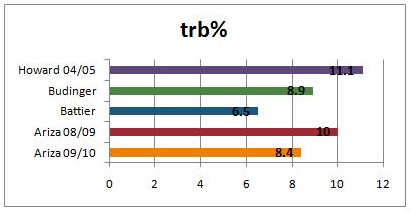
trb%is an estimate of the percentage of available rebounds a player grabbed while he was on the floor
While Ariza fares comparably on the defensive glass, Howard was much more dangerous crashing the offensive boards.
However, Ariza’s orb% last season was over double that of what it is this year. For this reason, I don’t think it’s fair to attribute his drop in rebounding production this year to inability. The more likely explanation is Ariza’s new role with the Rockets. He has more ball handling duties and is involved directly in more plays, robbing him of opportunities to scramble off the ball.
However, as this is all speculative, I will refrain from passing further judgment on Ariza’s rebounding.
Defense
Good defender; Plays passing lanes well
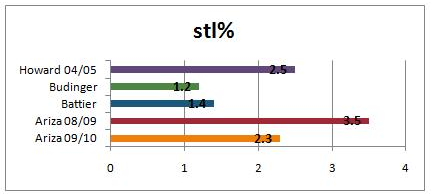
stl% is defined as an estimate of the percentage of opponent possessions that end with a steal by the player while he was on the floor
Nothing unusual here as Ariza is currently #10 in the league in the steals department.
However, this may come as a surprise:
To be more precise, DRtg for individual players is an estimate for their individual contribution towards their team’s defensive efficiency. It is based purely on box score statistics and does not distinguish how many points are allowed specifically with the player on the floor. It would be foolish to draw any conclusions from Ariza’s 105 vs. Battier’s 108 because the former is given credit for steals and rebounds.
In watching him this year, I no longer think Ariza is a good defender.
The issue of Ariza’s defense is controversial. Steals are not indicative of man-to-man defensive ability. In Ariza’s case, his teammates are left to scramble to cover for him when he fails to come up with the steal. I personally feel that the conservative approach of Shane Battier is far more beneficial to a team’s defense.
With that said, there is merit to the counter-argument. Trevor’s approach may help the team because they need to create chaos in order to have success. Because the ‘bigs’ rotate so well, the damage from his failed gambles may not be so harmful. Hoop Numbers shows that Ariza was in the top percentile in impacting forced turnovers against the opposition last year. It could be the case that the pressure he applies more than offsets its negatives.
Other Thoughts
- Ariza is not a part of any of any of the team’s top three most efficient offensive units.
- The above is interesting because it seems to indicate that the team is much better with Trevor off the floor. However, this would be one of those cases when statistics become ‘damn lies.’ It is well known that the Rockets’ starters, as a group, struggle, and that their bench often outscores opponents by wide margins.
- Moreso than a lack of skill, Ariza’s greatest weakness is overall poor judgment and a complete lack of awareness of his surroundings. He routinely picks up his dribble, gets stuck in mid air with no escape route, and dribbles himself into awkward situations. But worst of all is the sense of overconfidence which he exudes on a nightly basis: he almost seems to have a mindset that passing out to an open teammate after getting trapped and picking up his dribble would be an admission of failure.
*
Part 1 Assertions
Will never become a go-to player on a good team
The belief by many fans prior to the season that Ariza could become a go-to player for the Rockets was so preposterous that it was beyond maddening. I don’t think I need to spend any more time here re-establishing my assertion. Anyone who has watched more than two games all year can recognize that Trevor Ariza is not a go-to player. He can’t create. Without that, it can’t be done.
Furthermore, Ariza is now shooting 27% from the field in the 4th/OT when there is less than 5 minutes left and neither team is ahead by more than 5 points.
Perfect role player for this team
I still stand by this assertion. My reason is because I was referring to the long-term big picture and Trevor’s role on a team with both Yao Ming and Tracy McGrady.
Ariza is struggling right now simply because he is not suited for his current role. He’s just not skilled enough to have the responsibilities he currently has in this offense.
(At the same time, I don’t blame Rick for experimenting because this year is the only chance he will get for that.)
If Yao returns and another impact player is acquired, I do still think that Trevor can be a very productive role player for this team. As I said earlier, Ariza is at his best when put in situations where he does not need to make decisions with the basketball. If playing next to dominant offensive players, when the defense gives them heightened attention, Ariza can thrive by slashing to the hoop or spotting up.
If given the same amount of attention as his other four teammates and required to create on his own, as has been the case this year, Ariza is just not very good. The results this year don’t exactly come as a shock.
This signing was a ‘slam dunk’
Many have recently expressed their disappointment with the signing, stating that it was a blunder on Morey’s part. I strongly disagree and still feel this was a very good signing.
We can all agree that Ariza has performed very poorly up to this point. I personally think his production will improve if/when the team personnel is upgraded (via Yao’s return or a trade), but let’s set even that aside.
Regardless of his actual production, this was a good signing simply because it gave the team another plus asset. It doesn’t matter how poorly he performs – Ariza is just 24, earning just the league average, and has significant contributions to a title team on his resume. He can easily be traded.
An acquisition is not just judged by on-court outcomes. It still has value if it can be easily passed on for something else. That’s the case with Ariza.



